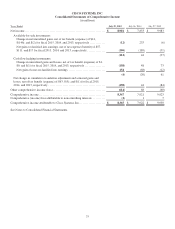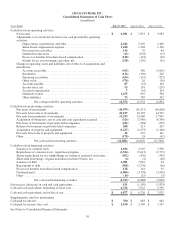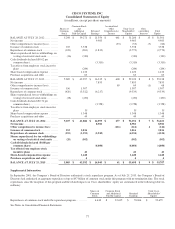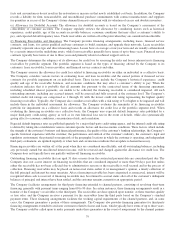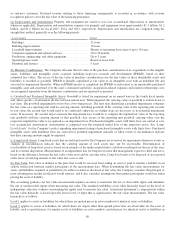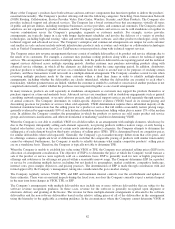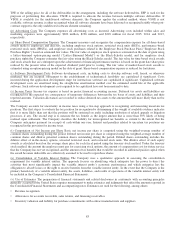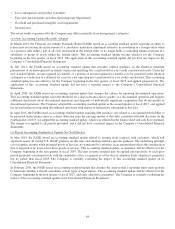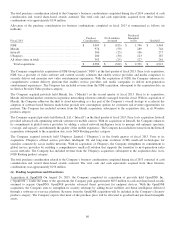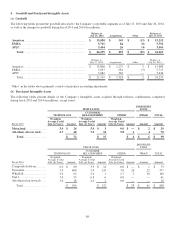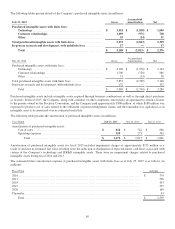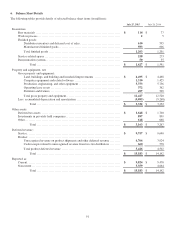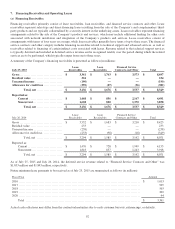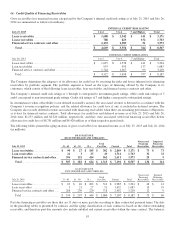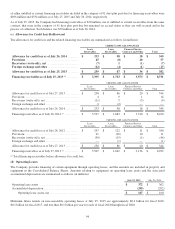Cisco 2015 Annual Report Download - page 92
Download and view the complete annual report
Please find page 92 of the 2015 Cisco annual report below. You can navigate through the pages in the report by either clicking on the pages listed below, or by using the keyword search tool below to find specific information within the annual report.
• Loss contingencies and product warranties
• Fair value measurements and other-than-temporary impairments
• Goodwill and purchased intangible asset impairments
• Income taxes
The actual results experienced by the Company may differ materially from management’s estimates.
(w) New Accounting Updates Recently Adopted
In March 2013, the Financial Accounting Standards Board (FASB) issued an accounting standard update requiring an entity to
release into net income the entire amount of a cumulative translation adjustment related to its investment in a foreign entity when
as a parent it sells either a part or all of its investment in the foreign entity or no longer holds a controlling financial interest in a
subsidiary or group of assets within the foreign entity. This accounting standard update became effective for the Company
beginning in the first quarter of fiscal 2015. The application of this accounting standard update did not have any impact to the
Company’s Consolidated Financial Statements.
In July 2013, the FASB issued an accounting standard update that provides explicit guidance on the financial statement
presentation of an unrecognized tax benefit when a net operating loss carryforward or a tax credit carryforward exists. Under the
new standard update, an unrecognized tax benefit, or a portion of an unrecognized tax benefit, is to be presented in the financial
statements as a reduction to a deferred tax asset for a net operating loss carryforward or a tax credit carryforward. This accounting
standard update became effective for the Company beginning in the first quarter of fiscal 2015 and applied prospectively. The
application of this accounting standard update did not have a material impact to the Company’s Consolidated Financial
Statements.
In April 2014, the FASB issued an accounting standard update that changes the criteria for reporting discontinued operations.
This accounting standard update raises the threshold for a disposal transaction to qualify as a discontinued operation and requires
additional disclosures about discontinued operations and disposals of individually significant components that do not qualify as
discontinued operations. The Company adopted this accounting standard update in the second quarter of fiscal 2015, and applied
the revised criteria for reporting discontinued operations with respect to transactions subsequent to this date.
In April 2015, the FASB issued an accounting standard update requiring debt issuance costs related to a recognized debt liability to
be presented in the balance sheet as a direct deduction from the carrying amount of that debt, consistent with debt discounts. In the
fourth quarter of 2015, we adopted the accounting standard update, which was reflected in the balance sheet and cash flow statement.
The change was applied to all periods presented, and it did not have a material impact on the Company’s Consolidated Financial
Statements.
(x) Recent Accounting Standards or Updates Not Yet Effective
In May 2014, the FASB issued an accounting standard update related to revenue from contracts with customers, which will
supersede nearly all current U.S. GAAP guidance on this topic and eliminate industry-specific guidance. The underlying principle
is to recognize revenue when promised goods or services are transferred to customers in an amount that reflects the consideration
that is expected to be received for those goods or services. This accounting standard update, as amended, will be effective for the
Company beginning in the first quarter of fiscal 2019. The new revenue standard may be applied retrospectively to each prior
period presented or retrospectively with the cumulative effect recognized as of the date of adoption. Early adoption is permitted,
but no earlier than fiscal 2018. The Company is currently evaluating the impact of this accounting standard update on its
Consolidated Financial Statements.
In February 2015, the FASB issued an accounting standard update that changes the analysis that a reporting entity must perform
to determine whether it should consolidate certain types of legal entities. The accounting standard update will be effective for the
Company beginning in the first quarter of fiscal 2017, and early adoption is permitted. The Company is currently evaluating the
impact of this accounting standard update on its Consolidated Financial Statements.
84



